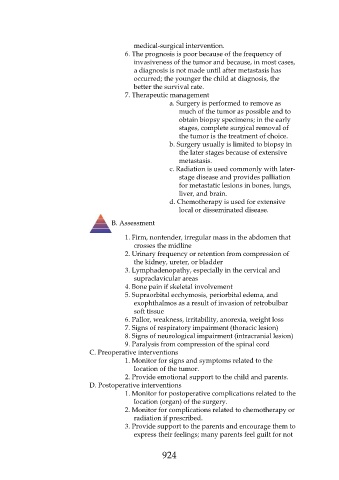Page 924 - Saunders Comprehensive Review For NCLEX-RN
P. 924
medical-surgical intervention.
6. The prognosis is poor because of the frequency of
invasiveness of the tumor and because, in most cases,
a diagnosis is not made until after metastasis has
occurred; the younger the child at diagnosis, the
better the survival rate.
7. Therapeutic management
a. Surgery is performed to remove as
much of the tumor as possible and to
obtain biopsy specimens; in the early
stages, complete surgical removal of
the tumor is the treatment of choice.
b. Surgery usually is limited to biopsy in
the later stages because of extensive
metastasis.
c. Radiation is used commonly with later-
stage disease and provides palliation
for metastatic lesions in bones, lungs,
liver, and brain.
d. Chemotherapy is used for extensive
local or disseminated disease.
B. Assessment
1. Firm, nontender, irregular mass in the abdomen that
crosses the midline
2. Urinary frequency or retention from compression of
the kidney, ureter, or bladder
3. Lymphadenopathy, especially in the cervical and
supraclavicular areas
4. Bone pain if skeletal involvement
5. Supraorbital ecchymosis, periorbital edema, and
exophthalmos as a result of invasion of retrobulbar
soft tissue
6. Pallor, weakness, irritability, anorexia, weight loss
7. Signs of respiratory impairment (thoracic lesion)
8. Signs of neurological impairment (intracranial lesion)
9. Paralysis from compression of the spinal cord
C. Preoperative interventions
1. Monitor for signs and symptoms related to the
location of the tumor.
2. Provide emotional support to the child and parents.
D. Postoperative interventions
1. Monitor for postoperative complications related to the
location (organ) of the surgery.
2. Monitor for complications related to chemotherapy or
radiation if prescribed.
3. Provide support to the parents and encourage them to
express their feelings; many parents feel guilt for not
924

